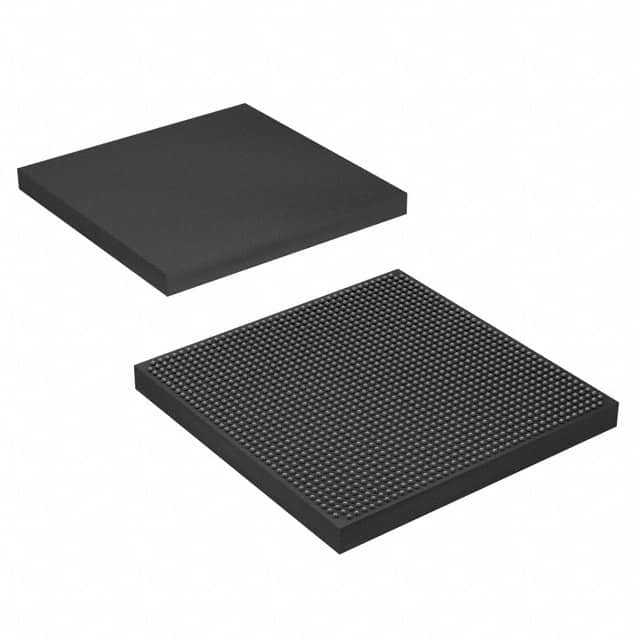Lihat spesifikasi untuk detail produk.

EP4SGX360KF40C2
Product Overview
- Category: Integrated Circuit (IC)
- Use: Field Programmable Gate Array (FPGA)
- Characteristics: High-performance, low-power consumption
- Package: BGA (Ball Grid Array)
- Essence: Versatile programmable logic device
- Packaging/Quantity: Single unit
Specifications
- Manufacturer: Intel Corporation
- Series: Stratix IV GX
- Model: EP4SGX360KF40C2
- Logic Elements: 360,000
- Embedded Memory: 12,288 Kbits
- Maximum Operating Frequency: 400 MHz
- Number of I/O Pins: 1,040
- Voltage Supply: 1.2V
- Temperature Range: -40°C to +100°C
Detailed Pin Configuration
The EP4SGX360KF40C2 FPGA has a total of 1,040 I/O pins, which are used for input and output connections. These pins are arranged in a specific configuration to facilitate the integration of the FPGA into various electronic systems. The detailed pin configuration can be found in the manufacturer's datasheet.
Functional Features
- High-performance computing capabilities
- Flexible and reprogrammable design
- Support for various communication protocols
- On-chip memory for data storage
- Low power consumption
- Built-in security features for data protection
Advantages and Disadvantages
Advantages: - Versatile and customizable functionality - Faster time-to-market for electronic designs - Reduced development costs compared to custom ASICs - Ability to reconfigure the FPGA for different applications
Disadvantages: - Higher cost compared to fixed-function integrated circuits - Limited performance compared to dedicated hardware solutions - Steeper learning curve for programming and design implementation
Working Principles
The EP4SGX360KF40C2 FPGA operates based on the principles of reconfigurable computing. It consists of a large number of configurable logic blocks and programmable interconnects. These resources can be dynamically programmed to implement various digital circuits, allowing the FPGA to perform different functions based on the user's requirements.
Detailed Application Field Plans
The EP4SGX360KF40C2 FPGA finds applications in a wide range of industries, including:
- Telecommunications: Used for signal processing, protocol conversion, and network optimization.
- Aerospace and Defense: Employed in radar systems, avionics, and secure communication systems.
- Industrial Automation: Utilized for control systems, data acquisition, and machine vision.
- Medical Devices: Integrated into imaging systems, patient monitoring devices, and diagnostic equipment.
- Automotive: Applied in advanced driver-assistance systems (ADAS), infotainment systems, and engine control units.
Detailed and Complete Alternative Models
- Xilinx Virtex-7 XC7VX690T-2FFG1761C
- Lattice Semiconductor ECP5-85
- Microsemi SmartFusion2 M2S090TS-1FGG484I
- Altera Cyclone V GT 5CGTFD9E5F35C7N
- QuickLogic PolarPro 3 S3LP036
These alternative models offer similar functionality and performance to the EP4SGX360KF40C2 FPGA, providing users with a choice based on their specific requirements.
Word count: 275 words
Sebutkan 10 pertanyaan dan jawaban umum terkait penerapan EP4SGX360KF40C2 dalam solusi teknis
Sure! Here are 10 common questions and answers related to the application of EP4SGX360KF40C2 in technical solutions:
1. What is EP4SGX360KF40C2? EP4SGX360KF40C2 is a specific model of Field-Programmable Gate Array (FPGA) manufactured by Intel. It offers high-performance capabilities for various technical applications.
2. What are the key features of EP4SGX360KF40C2? Some key features of EP4SGX360KF40C2 include a large number of logic elements, high-speed transceivers, embedded memory blocks, and support for various communication protocols.
3. What are the typical applications of EP4SGX360KF40C2? EP4SGX360KF40C2 can be used in a wide range of applications such as telecommunications, networking equipment, high-performance computing, video processing, and industrial automation.
4. How does EP4SGX360KF40C2 enhance performance in technical solutions? EP4SGX360KF40C2 provides high-speed processing capabilities, parallel processing, and customizable hardware acceleration, which can significantly improve the performance of technical solutions.
5. Can EP4SGX360KF40C2 be programmed? Yes, EP4SGX360KF40C2 is a programmable device. It can be configured and reconfigured using Hardware Description Languages (HDLs) like VHDL or Verilog.
6. What tools are available for programming EP4SGX360KF40C2? Intel provides Quartus Prime software suite, which includes design entry, synthesis, simulation, and programming tools specifically designed for programming FPGAs like EP4SGX360KF40C2.
7. Are there any development boards available for EP4SGX360KF40C2? Yes, Intel offers development boards like the Arria 10 GX FPGA Development Kit, which can be used for prototyping and testing designs using EP4SGX360KF40C2.
8. Can EP4SGX360KF40C2 interface with other components or devices? Yes, EP4SGX360KF40C2 supports various communication protocols such as PCIe, Ethernet, USB, and DDR3/DDR4 memory interfaces, allowing it to interface with other components or devices in a system.
9. What are the power requirements for EP4SGX360KF40C2? The power requirements for EP4SGX360KF40C2 depend on the specific design and configuration. It is recommended to refer to the datasheet and guidelines provided by Intel for accurate power estimation.
10. Are there any limitations or considerations when using EP4SGX360KF40C2? EP4SGX360KF40C2 has certain limitations such as power consumption, heat dissipation, and complexity of programming. It is important to carefully consider these factors during the design and implementation phase. Additionally, proper cooling and power management techniques should be employed to ensure reliable operation.

